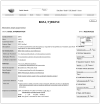Saccharomyces genome database: underlying principles and organisation
- PMID: 15153302
- PMCID: PMC3037832
- DOI: 10.1093/bib/5.1.9
Saccharomyces genome database: underlying principles and organisation
Abstract
A scientific database can be a powerful tool for biologists in an era where large-scale genomic analysis, combined with smaller-scale scientific results, provides new insights into the roles of genes and their products in the cell. However, the collection and assimilation of data is, in itself, not enough to make a database useful. The data must be incorporated into the database and presented to the user in an intuitive and biologically significant manner. Most importantly, this presentation must be driven by the user's point of view; that is, from a biological perspective. The success of a scientific database can therefore be measured by the response of its users - statistically, by usage numbers and, in a less quantifiable way, by its relationship with the community it serves and its ability to serve as a model for similar projects. Since its inception ten years ago, the Saccharomyces Genome Database (SGD) has seen a dramatic increase in its usage, has developed and maintained a positive working relationship with the yeast research community, and has served as a template for at least one other database. The success of SGD, as measured by these criteria, is due in large part to philosophies that have guided its mission and organisation since it was established in 1993. This paper aims to detail these philosophies and how they shape the organisation and presentation of the database.
Figures





References
-
- SGD (Saccharomyces Genome Database) Stanford University; URL: http://www.yeastgenome.org [cited 9th October, 2003]
-
- ACEDB Documentation . The Wellcome Trust Sanger Institute; URL: http://www.acedb.org/Documentation/[cited 9th October, 2003]
-
- SGD Usage Statistics . Stanford University; URL: http://genome-www.stanford.edu/usage/sgd/[cited 9th October, 2003]
-
- DictyBase URL: http://dictybase.org [cited 9th October, 2003]
-
- SGD ftp site . Stanford University; URL: ftp://genome-ftp.stanford.edu/pub/yeast/[cited 9th October, 2003]
MeSH terms
Grants and funding
LinkOut - more resources
Full Text Sources
Molecular Biology Databases

